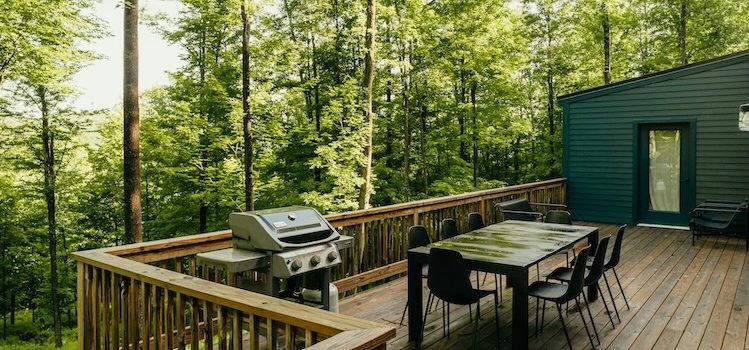Decking
Composite Decking vs Wood: Which Is Right for Your Outdoor Project?

Composite Decking vs Wood: Compare durability, maintenance, and value with help from Builders Surplus
Thinking about building a new deck or replacing an old one? Choosing the right material is one of the most important decisions you’ll make. When it comes to composite decking vs wood, each has its own benefits—so how do you decide what’s best for your space, budget, and lifestyle?
At Builders Surplus, we supply homeowners and contractors throughout Rhode Island, Connecticut, and Massachusetts with top-quality decking products—including Meranti mahogany wood and composite decking options—at unbeatable prices. Let’s explore the key differences so you can build smarter.
Need help planning your deck? Call 866-739-1636 or reach out on our contact page to talk with our friendly, knowledgeable team today!
The Basics: What’s the Difference?
Wood decking is made from natural lumber, commonly cedar, redwood, pressure-treated pine, or hardwoods like mahogany. It offers classic beauty and natural grain that many homeowners love.
Composite decking, on the other hand, is a man-made product crafted from a mix of wood fibers and recycled plastic. It’s designed to mimic the look of wood, without some of the downsides.
1. Appearance and Style
Wood decking boasts natural beauty. Each plank has its own unique grain, and it can be stained or painted in any color you like. If you’re going for a rustic or traditional look, wood is tough to beat.
Composite decking, however, has come a long way in recent years. Many products now feature realistic woodgrain textures and rich colors that stay vibrant longer than stained wood.
Verdict:
- Go with wood for a warm, authentic look
- Choose composite if you want color consistency and low-fade finishes
2. Durability and Longevity
Wood decks are durable, but they’re vulnerable to the elements. Without regular maintenance, wood can splinter, warp, rot, or be affected by pests like termites.
Composite decking resists rot, warping, and insects. It doesn’t splinter and won’t crack due to moisture. Most composite decking products come with warranties ranging from 15 to 30 years.
Verdict:
- Composite lasts longer with less upkeep
- Wood can be long-lasting, but only with diligent maintenance
3. Maintenance Requirements
Wood requires routine care to stay in good shape. You’ll need to pressure wash it annually and restain or reseal it every couple of years to protect against moisture and UV damage.
Composite decking is low-maintenance. No staining, sealing, or sanding—just an occasional wash with soap and water to keep it looking fresh.
Verdict:
- Choose wood if you’re okay with hands-on seasonal upkeep
- Choose composite for a “set it and forget it” experience
4. Cost Considerations
Wood is often less expensive upfront, especially pressure-treated lumber. Premium hardwoods like mahogany cost more, but many homeowners feel it’s worth it for the look and strength.
Composite decking costs more initially, but savings come later thanks to minimal maintenance and long lifespan. You won’t need to buy stain, sealant, or replacement boards every few years.
Verdict:
- Wood wins on upfront cost
- Composite may save you more in the long run
5. Environmental Impact
Wood decking can be sustainable if sourced from responsibly managed forests. However, pressure-treated lumber involves chemicals that may be harmful over time.
Composite decking often contains recycled materials, including reclaimed wood and plastic. It doesn’t require staining or sealing, which reduces the need for chemical-based products.
Verdict:
- Choose wood from FSC-certified sources for sustainability
- Choose composite if you want a low-maintenance, eco-conscious alternative
6. Slip and Heat Resistance
Wood can get slippery when wet, especially if not treated or maintained properly. In hot summer sun, darker wood may become hot to the touch.
Composite decking can also heat up in full sun, but many brands now offer heat-resistant and textured surfaces for better grip and comfort.
Verdict:
- Both materials benefit from light colors and shaded installs
- Composite offers more surface technology options for safety
Builders Surplus Picks: What We Carry
At Builders Surplus, we stock Meranti mahogany decking—a high-quality, naturally resistant hardwood that’s ideal for decks in New England. Thanks to its rich color, smooth surface, and durability, it’s a customer favorite.
We also offer composite decking options that are ideal for homeowners who want a no-fuss, long-term solution. Ask about our current selection and availability—it changes regularly!
Be sure to call your local store in advance to find out what’s in stock.
Final Thoughts: Composite Decking vs Wood
So, which is better: composite decking vs wood? It really depends on what matters most to you. Here’s a quick recap:
| Feature | Wood | Composite |
| Appearance | Natural, warm, customizable | Consistent color, wood-like look |
| Durability | Can warp or rot over time | Resists moisture, insects, and wear |
| Maintenance | Needs regular upkeep | Easy to clean, no sealing required |
| Initial Cost | Generally lower | Higher upfront, lower long-term |
| Eco-Friendliness | Can be sustainable | Often made with recycled content |
Build Smarter with Builders Surplus
Whether you’re dreaming of a classic wood deck or a modern composite setup, Builders Surplus has the materials and guidance you need—without the big-box store markup. Our experts are here to help you compare products, plan your layout, and save on your next outdoor project.
Visit one of our five New England locations or reach out online. Call 866-739-1636 today to get started on your perfect summer deck.
Photo by Clay Banks on Unsplash
